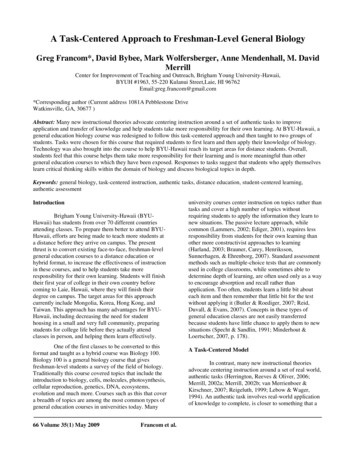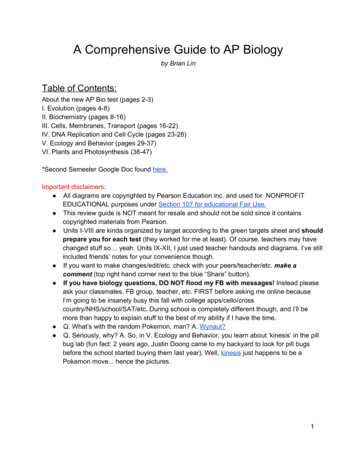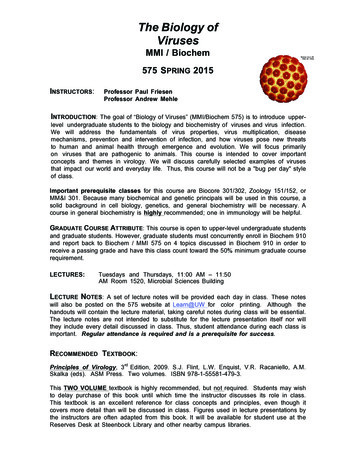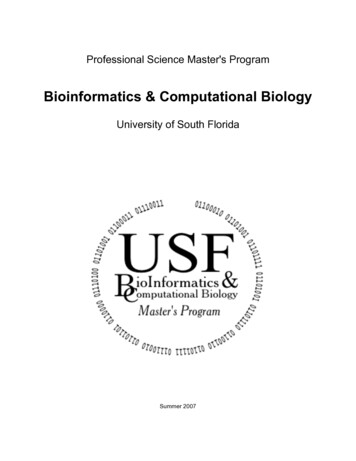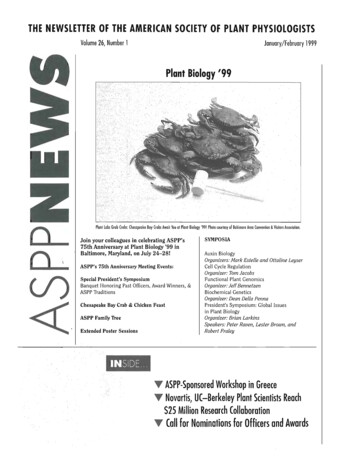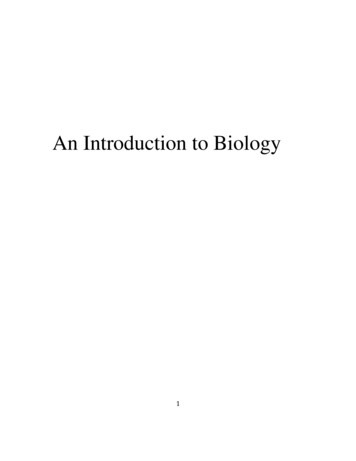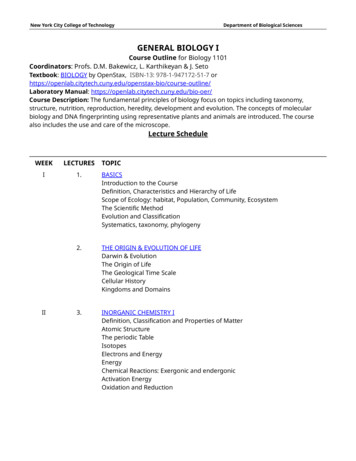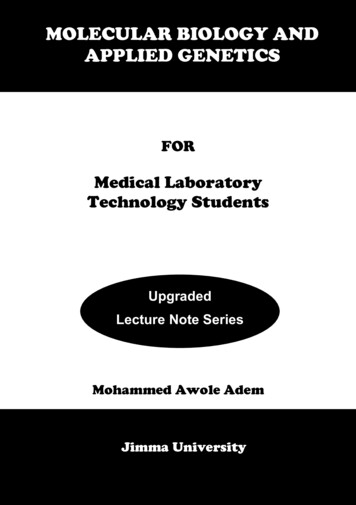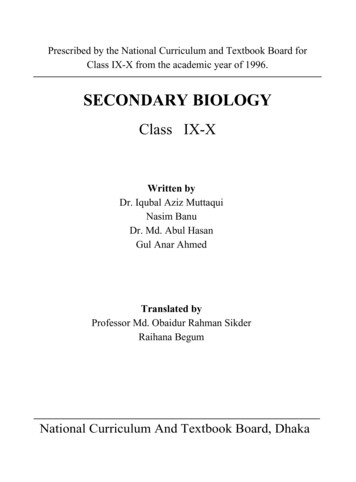
Transcription
Prescribed by the National Curriculum and Textbook Board forClass IX-X from the academic year of 1996.SECONDARY BIOLOGYClass IX-XWritten byDr. Iqubal Aziz MuttaquiNasim BanuDr. Md. Abul HasanGul Anar AhmedTranslated byProfessor Md. Obaidur Rahman SikderRaihana BegumNational Curriculum And Textbook Board, Dhaka
Published byNational Curriculum and Textbook Board67-70, Motijheel Commercial Area, Dhaka[All rights reserved by the Publisher]First Print : 1998Second Edition: 2007Reprint April : 2009Reprint October :Computer ComposePerform Color Graphics (Pvt) Ltd.IllustrationArif Reza KhanAbu Hasmi Md. FaisalDesignNCTB, DhakaFor free distribution from academic year 2012 by the Government of Bangladesh.Printed by :
PREFACEEducation is the key to development. A progressively improved educationsystem largely determines the pace and the quality of national development. Toreflect the hopes and aspirations of the people and the socio-economic andcultural reality in the context of the post independent Bangladesh, newtextbooks were introduced in the beginning of the 1980s following therecommendations of the National Curriculum and Textbook Committee.In 1994, in accordance with the need for change and development, thetextbooks of lower secondary, secondary and higher secondary were revisedand modified. The textbooks from classes VI to IX were written in 1995. in2000, almost all the textbooks were rationally evaluated and necessary revisionwere made. In 2008, the Ministry of Education formed a Task Force forEducation. According to the advice and guidance of the Task Force, the cover,spelling and information in the textbooks were updated and corrected.To make assessment more meaningful and in accordance with the need of thecurriculum, Creative Questions and Multiple Choice Questions are given at theend of each chapter. It is hoped that this will reduce the dependency of studentson rote memorisation. The students will be able to apply the knowledge theyhave gained to judge, analyses and evaluate real life situation.In the revised curriculum. Botany & Zoology has been included in one bookBiology. The study of Biology has been Presanted through both theory andpractical classes. The practical experiments have been given separately.Students can gain knowledge about Biology and their interest in science willincrease when they complete the experiments with the help of the teachers. Ihope that the textbook of Biology properly reflects the objectives of thecurriculum.This book of Biology for class IX & X is the English Version of the originaltextbook entitled 'Maydhamic Gibobiggayan' written in Bangla.We know that curriculum development is a continuous process on whichtextbooks are written. Any logical and formative suggestions for improvementwill be considered with care. On the event of the golden jubilee of theIndependence of Bangladesh in 2021, we want to be a part of the ceaselesseffort to build a prosperous Bangladesh.In spite of sincere efforts in translation, editing and printing some inadvertenterrors and omissions may be found in the book. However, our efforts to makeit more refined and impeccable will continue. Any constructive suggestiontowards its further improvement will be gratefully considered.I thank those who have assisted us with their intellect and effort in the writing,editing and rational evaluation of this book. We hope that the book will beuseful for the students for whom it is written.Prof. Md. Mostafa KamaluddinChairmanNational Curriculum and Textbook BoardDhaka
ContentsChapterTopicsPage1Introduction to Biology12Structure and Nature of living Cell153Cell Division284Division of Labour in Multicellular Plants: Tissue and36Tissue System5Animal Tissue, Organ and Organ System466Classification of Plants627Animal Diversity and Classification788Structural Organization and Acquaintance of Animals959Physiological Activities in Plants : Nutrition164Imbibition, Osmosis, Ascent of Sap And Transpiration168Photosynthesis and Respiration182Growth and Development of Plants19910Flower20711Pollination, Fertilization and dispersal of fruits and216seeds12Reproduction of Plants22813Organism and Environment23214Pollution and Conservation of Environment24715Natural Diversities of Bangladesh-Distribution of260Plants and Animals16Economic Biology300Practical Botany314Practical Zoology334
CHAPTER ONEINTRODUCTION TO BIOLOGYNow a days we find contributions of Aristotle, Socrates, Theophrastus andmany other scholars of the past age in different fields of knowledge. This is notpossible for the scholars of the present time. A question may arise in your mindas to why it is not possible today. The reason is that in ages long past the extentof knowledge was limited. People engaged in achieving knowledge were alsosmall in number. Today the dimension of knowledge has been increased manytimes. To contribute in more than one field is quite difficult at the present time.For convenience to know and understand things we have divided our world ofknowledge in many branches. In this way Science, Literature, Arts, SocialScience and many other branches have been created. As a whole, knowledge ofhuman beings is undivided. But it has been divided into various branches foreasy learning and understanding.You may have known that the knowledge of science is increasing rapidly. It isbecoming possible because of the research of a large number of scientists indifferent fields of science. Many people think that knowledge of science isbecoming double in every eight years. New subjects of science are beingcreated. It is not possible to realize and understand this huge store ofknowledge for an individual alone. As a result, scientists are engaged inresearch in particular subject or topic. At different times many scholars havedivided the knowledge of science in various ways. The division and differentbranches of science are constantly spreading with the increase of knowledge inscience. The two main branches of science are Physical science and BiologicalScience.Physical Science is otherwise called the Science of non-living things. InPhysical science characteristics, actions-reactions, multiformaity and manysimilar other properties of non-living objects are examined and discussed.
2Secondary BiologyObservation, examination and discussion of livings beings are included inBiology. Biology is the science of living beings. The term Biology comes fromtwo Greek words (bios means life and logos means knowledge). Aristotle isregarded as the father of Biology.We find two types of life in nature. One is plant while the other is animal.Accordingly Biology has been divided into two branches: Botany and Zoology.Botany deals with theoretical discussion and research about characters andother features of plants, while Zoology is limited in subjects relating toanimals.PRINCIPAL BRANCHES OF BIOLOGYBiology has been divided into Botany and Zoology on the basis of nature ofliving beings. Inspite of this, now-a-days extensive research has been done onMicroorganism. They influence human life in various ways. So for discussionabout them a new branch is made. This is known as Microbiology.Considering the subjects of living bodies on which discussion is made thewhole range of Biology is divided into the following main branches.1. Morphology: This branch deals with both the external and internalstructures of organism. The subject concerning internal . structures is alsoknown as Anatomy.2. Cytology: Each living organism consists of one or more cells. Structuresand functions of cells are treated in this branch of Biology.3. Histology: In this branch discussion is made on structure, location andfunction of different tissues.4. Physiology: This branch includes all the activities of living things e.ggrowth respiration, excretion, photosynthesis and other biological activities.5. Taxonomy: In this branch discussion is made on identificationnomenclature, and classification of plants and animals into groups andsubgroups.
Intorduction to Biology36. Genetics: How different characters are inherited from parents to offsprings,and how the processes can be controlled and improved etc. are brought understudy and research in this branch.7. Ecology: This branch considers the effects of environment on livingorganisms or living communities and also interaction between them.8. Evolution: This branch deals with the origin and successive transformationsof living organisms.The groups discussed above are the basic branches of Biology. Scientistsgradually started to utilize the knowledge of these branches for human welfare,and as a result applied branches of Biology were created. Agriculture,Medical science, Breeding etc. are some of the important applied branches ofBiology. Applied Biology also includes Forestry and Horticulture, Fishery,Pest Control. Animal Husbandry etc.There are numerous varieties of plants and animals on earth. Generally similarplants or animals are arranged in particular groups. Some special branches ofBiology have been created on the basis of different types of living things areunder discussion and research: for example. Phycology includes only membersof algae; fungi are treated in Mycology; Virology deals with viruses only;bacteria are considered in Bacteriology; Helminthology is based on study ofworms only; insects are discussed in Entomology.Each of the above mentioned divisions has been divided into subdivisions orbranches. It has been mentioned earlier that research in Biological fields hasgreatly extended now-a-days.Biology, as it appears today, was not the same the past 50 years ago. It wasbelieved that sweat-soaked warm clothing of men and some wheat, if kepttogether in a box for few days, rats would be produced. This wrong conceptabout the origin of life prevailed for a long time. Subsequently ideas aboutorigin of life have changed by the research works of various scientists. Modern
4Secondary BiologyBiology is the result of research and thinking of some great scientists. Thischapter introduces you with some of these scientists.Aristotle (384-322 B.C): The great Greek scientist, Aristotle is regarded as thefather of Zoology. He first established Zoology as a branch of Science.Aristotle was simultaneously a scientist, poet, thinker and philosopher. It is hewho first mentioned about the basic similarities in the structure of plants andanimals. He stayed in an island named Lesbos for five years continuously andmade research on animals. He wrote a book on animals and named it "Historiaanimalium" which is full of information and knowledge.Theophrastus (370-285 B.C.): Little amount of works of the Greekphilosopher Theophrastus is known to us. Of those available, nine volumes of"On the History of Plants" and six volumes of "On the causes of plants" areimportant. Theophrastus was the pupil of great philosopher Aristotle. Hedivided the plant community into four groups. For example: Trees shrubs,Undershrubs and Herbs. He is regarded as the Father of Botany.Al Biruni (973-1048): Known as an world famous scientist and educationist.Al Biruni was an Arabian citizen. His real name is Abu Raihan MohammadIbne Ahmed Al Biruni. He made contributions in different branches of science.He visited India during the reign of Sultan Mahmud of Ghazni and describedthe conditions prevailing in India in an attractive way.Ibne Sina (980-1037): He was a renowned Muslim philosopher and scientist.He had excellent skill in Chemistry, Medicine, Mathematics, Astronomy andLiterature. His full name is Abu Ali Hussain Ibne Abdullah Ibne Sina. Hecomposed more than hundred books on different subjects. Sixteen of whichwere written on Medicine. He had a fourteen volume compositions named AlKanun' on Medicine.
Secondary Biology5A1 Nafis: He was an Arabian scientist. He first (300 years before WilliamHarvey) described correctly the system of blood circulation in human body. Hewas also a successful physician. His actual name was Abu Al Hasan Ali IbneAl Nafis, He dedicated himself in the field of science for a long time, and diedin Damascus at the age of eighty.William Harvey (1578-1657): William Harvey was a British scientist. Herediscovered the system of blood circulation in 1628 and as a result some of theprevious ideas about it came to an end. In 1651 he pointed out that life startsfrom the egg cell. He is considered to be the father of Animal Physiology. Heclearly described the systems of blood circulation and excretion in animals, andexplained the relationship between the two processes. He published a book "Onthe motion of the heart and blood in animals".Anthony Von leenwenhoek (1632-1723): Dutch scientist leeuwenhoek firstbuilt the microscope. But his microscope was not like that of today.Descriptions of bacteria, nerve cell, Hydra, Volvax, etc. were written by him onobservations through his microscope. They have been found to be preciselycorrect.Carolus Linnaeus (1707-1778): Swedish scientist Linnaeus introduced thesystem of Binomial Nomenclature for plants and animals. A physician byprofession, he was the professor of physiology in Uppsala University, Sweden.Collecting numerous plants and animals he classified them and made theirnomenclature. His "Systema Naturae" composed on classification of livingbeings is a famous research work. Besides this his other two famous Botanicalbooks titled "Species Plantarum" and "Genera Plantarum" are based onresearch work. He is considered to be the father of modern Taxonomy.Charles Robert Darwin (1809-1882): English naturalist Darwin introducedthe Theory of Natural Selection. He expressed his findings and ideas in hisfamous research publication, "Origin of Species by Means of Natural
6Secondary BiologySelection" in the year 1859, after observing the living communities ofGalapagos Islands.Alfred Russel Wallace (1823-1913): English naturalist Wallace madeobservation and research works in the Amazon plateau for four years. Hisrenowned book Travels on the Amazon and Rio Negro" was written on thisexperience. He wrote "The Malay Archipelago" on his eight years researchexperience in Malay Peninsula. The huge collection of insects he made hasbeen kept preserved in the Hope collection centre of Oxford University. He isfamous for the introduction of Natural Selection Theory along with CharlesDarwin.Gregor Johann Mendel (1822-1884): Austrian Priest Mendel performedresearch work with pea plants in his church garden for a long time. Based onthis research he established two laws concerning genetics, which are followedtill today. He is regarded as the father of Genetics.George Bentham (1800-1884): The most notable work of this EnglishBotanist is the composition of three volumes of "Genera Plantarum" along withJoseph Dalton Hooker.Other books written by him are Handbook of theBritish Flora'. Flora Hongkongensis', Flora Australiensis' etc.Thomas Henly Huxley (1825-1895): Renowned British Zoologist T.H.Huxley did a lot of works on birds. He termed birds as glorified reptiles' andproved that birds have been evolved from the reptilian ancestors. Besides, hemade extensive research on Zoology. He was a notable supporter of CharlesDarwin's theory of Natural Selection. Huxley described protoplasm as thephysical basis of life.
7Introduction to BiologyTheophrastusAristotleAnthony Von LeewenhoekCharles DarwinCarolus Linnaeus
8Secondary BiologyAlexander FlemingGregor johann MendelSelim AliWatsonAlexander Fleming (1881-1955): Alexander Fleming was a MicrobiologistsHe observed in 1918 that some bacterial growth stops in a culture media wherePenicaillium is grown. He tried to find out the reason behind it. From his questand research he subsequently discovered the drug penicillin that has savedmillions of lives. He won Nobel Prize along with two other winners in the year1945.David Prain: David Prain was an English physician. He obtained degree inmedicine from Aberdin and Edinburgh. Joining Indian Medical Service he cameto India in 1883. His first Place of Posting was Luxmipur in Noakhali.Later he started research with the plants of this region. He was the Director of
Introduction to Biology9Calcutta Botanical Garden from 1887 to 1897. His famous book, "BengalPlants", Published in two volumes, widely treats plants of Bangladesh andadjoining areas. "Flora of Sundribuns" is another notable book written by him.Salim Ali (1896-1987): Known as the Birdman of India, Salim Ali was arenowned ornithologist. He scientifically observed all birds of India and wrotean informative book. The title of the book is "The Indian Birds" In addition tothis he composed many other books on birds. His autobiography is also afamous publication. In 1983 the Indian Government awarded him"Padmabhushan" title in recognition of his research work.Sir Hans Krebs (1900-1981): English scientist Krebs won Nobel Prize in 1953along with F.A. Lipmann in medicine and physiology for his research work onmetabolism of cells. He was appointed as the departmental head ofBiochemistry in the Oxford University in 1954. Krebs cycle of respiration inliving beings is his discovery.James Watson and Francis Crick: The two British scientists, Watson andCrick are famous for making the model of the molecular structure of DNAwhich bears the hereditary factors of human beings. While carrying out theresearch for PhD Degree in Cambridge University they discovered themolecular structure of DNA in 1953. They won Nobel Prize in the year 1963for this work. Watson and Crick first noticed that DNA molecule is structurallya double helix and spiral.Melvin Calvin (Born in 1911): Calvin, a professor of California UniversityU.S.A. is famous for his research concerning the pathway of carbonassimilation in green plants. In co-operation with other scientist Bassham,discovered the biochemical steps of Carbon assimilation known as CalvinBassham pathway of photosynthesis. He obtained Nobel Prize in 1961.
10Secondary BiologyCHARACTERISTICS OF PLANTS AND ANIMALSTaking a few main characteristics from many we shall now compare plantswith animals.1. Size and shape: Plants have no definite size and shape while animals havedefinite size and shape.2. Life Time: Life time is not limited for plants and under suitable conditionsthey live for a long period. But animals live up to a certain length of timeunder suitable conditions.3. Growth: In suitable environment growth of many plants continue for a longperiod. Growth in animals takes place up to a certain stage of life and growthceases after that.4. Movement: Most land plants remain fixed in soil with the help of roots as aresult they cannot move. But some organs of plants may show somemovement. A few animals (Such as Sponge) are not capable of movement.Most of the animals can move freely.5. Nature of Food: Plants cannot take solid food Animals can take solid andliquid type of food.6. Nutrition: Plants are autotrophic, it can prepare food throughphotosynthesis. Animals cannot prepare their own food. For foods they areto depend on plants and other animals.7. Structure of Cell: A Plant cell has dead cell wall. Most of the mature cellshave a large vacuole and plastids. The animal cell has no cell wall and itcontains small vacuoles and centrioles.8.Reproduction: Plants reproduce by vegetative, asexual and sexualmethods. Reproduction in animals mainly takes place by sexualmethod.Vegetative and asexual reproduction may be found in some animals.9. There are different systems in animal body. But plants have no body system.
Introduction to ENTAL DEVELOPMENTThe two main branches of Biology are Botany and Zoology. In addition tothese, there are other branches and sub-branches of Biology. You have comeacross some of those in the preceding parts of this chapter. Now let us discussthe importance of Biology on the basis of knowledge you have alreadyattained.Agricultural science has many branches of which Agronomy, Horticulture,Plant breeding, plant pathology, Fishery, Animal husbandry, Poultry,Honeybee culture (Apiculture), Sericulture etc. are important. With theapplication of knowledge of these branches economic development is possible.Both plants and animals are the essential components of natural environment. Itis known to you that plants and animals are interdependent in many ways.Ecology makes us alert about the importance of plants and animals and also thenecessity of their presence in nature, Educated and conscious citizens can playimportant role in conservation and development of environment. Economicdevelopment sometimes produces adverse effects on natural environment.Environmental degradation and hazards can be encountered through properapplication of our knowledge in ecology, Economic solvency and goodenvironment help social development.NATURE AND ORIGIN OF LIFEYou know what nature is. We live in nature. We have soil, water, air differentplants, animals, insects and worms etc. all around us. All these togetherconstitute nature. Millions of years ago nature was not as we see it today. Norwill it remain the same after millions of years. This indicates that nature isalways changing. Nature undergoes changes due to various naturalforces such as river-currents, earthquakes, volcanic eruptions etc. Different human
12Secondary Biologyactivities, such as destruction of forests, construction of dams etc. also bringabout changes in nature.Scientists have been thinking about the origin of nature. There are differenttheories about the origin of the Earth. Among these the commonly acceptabletheory explains that a part of the Sun or a similar star got detached as a result ofthe attraction of another star. The planets including the Earth and then satelliteshave been created from the detached part of the sun.According to this theory at the beginning the Earth was in a hot, gaseous stateSubsequently the Earth gradually cooled and condensed to form the Earth as itis now. The core of the Earth is still in an extremely hot liquid and gaseousstate. Nature of the Earth at the primary stage was not at all suitable forinhabitation of life. Gradually it became favourable for the existence of livingforms. Now a question may arise in your mind as to how life originates innature. Did plants and animals exist in nature from the very beginning?There are different theories regarding the origin of life on the Earth. In thebeginning of this chapter we have described an old concept of the origin of lifeBut the theory presented by Oparin, a Russian scientist, about the origin of lifeis still accepted.According to the theory of Oparin nature was quite hot when life was createdDifferent gases such as ammonia (NH3), hydrogen (H2), methane (CH4)hydrogen cyanine (HCN) etc. were present in the atmosphere. During thatperiod there was heavy rainfall and thunderstorm. Under such environmentalcondition amino acids were formed by the interaction of various gases andthese amino acids are considered by scientists to be the first molecule of lifeThe first cell or life came into being through incorporation of amino acids. It isalso believed that life was created first in the primitive aquatic environment.
14Secondary Biology3. According to the Oparin's theory and established scientific reasons whichone of the following is correct if arranged chronologically from origin of lifeto the recent?a. Amino acidUnicellular AlgaeBacteriab. Amino acidc. Amino acidd. Amino acidUnicellular AmoebaBacteriaBacteriaUnicellular AlgaeBacteriaUnicellular Amoeba.Unicellular Amoeba.Unicellular Algae.Unicellular Amoeba.Unicellular Algae4. According to the Oparin's theory and established scientific reasonswhich one of the following animals came into being at the last in theterrestrial environment?a. Birdb. Manc. Buffalod. Banyan treeCreative questions1. Kalidas became curious about plants and animals when he was studying atShingua High School. Seeing his curiosity the teachers of that school advisedhim to study biology when he will be grown up. According to that adviseKalidash studied on Botany in the University. The subjects he studied includedboth pure and applied branches of Biology. But afterwards he started workingon applied branch and invented many high yielding fruits & crops. He is stillengaged in this works.a) What is Biology?b) Why is physiology called the pure branch of Biology?c) Explain that why is the works of Kalidash included in the applied branch ofBiology.d) Analyse the importance of pure branch in the success of Kalidash.
Introduction to Biology13The first cell had protoplasm, amino acid and later on DNA molecules areformed by union of amino acid molecules, But the cells did not have anynucleus. This non-nucleated cell successively gave rise to nucleated cell andmulticultural organism.ExerciseMultiple choice questions1) Why is Gregor Johann Mendel famous for?a. For Natural Selection theory.b. For the invention of blood circulation mechanism.c. For the invention of penicillin.d. For the law of heredity.2) Which scientist contributed much for detail description of plants inBangladesh?i. Aristotleii. Theophrastusiii. David PrainWhich of the following is correct?a. i.b. ii.c. iii.d. ii & iiiGive answer to the question no. 4 and 5 according to the followingparagraph.The theory presented by Oparin about the origin of life in nature is moreaccepted. According to the theory at the beginning of life amino acids, the firstmolecule of life were formed by the interaction of various gases. Then the firstcell or life came into being through incorporation of amino acids in the aquaticenvironment. The first cell did not have any nucleus. This non-nucleated cellgave rise to a nucleated cell and successively multicellular organisms.
CHAPTER-TWOStructure and Nature of Living CellThose who have life are living beings. Microorganisms, Plants and Animalshave life, so they all are living beings. Living world is composed ofmicroorganisms plants and animals. One or more cells make every livingbeing. Cell is the structural and functional unit of living body. All sorts ofreaction and anti- reaction in living body are cell centered. So to know aboutany living beings one should know about the living cell at first.All living cells are not alike. As they are, different in structure, they aredifferent in size, shape and functions. Different types of cell are describedbelow in brief.All the cells of Plants and Animals are eukaryotic but they have differences aswell. Difference between Plant cell and Animal cell are shown in a tabularform at the end of this chapter. However the main difference between them isthe Plant cells have a non-living cell wall, which is absent in the Animal cells.Smooth Endoplasmic reticulumMicrovilusCell wallGolgibodyChloroplastCell membraneVacuoleCentrosomeCentriolNuclear wallCytoplasmNucleolusChromatin fiberNuclear poreMitochondrionAnimal cellRough Endoplasmic reticulumPlant cellFig : 2.1 :- Generalised Plant and Animal Cells (Seen under Electron Microscope)
16Secondary BiologyA. On the basis of Nuclear StructureProkaryotie cell or Proto cell : Nucleus is not well organized in these cells;nuclear membrane and nucleolus are absent here. In these cells Chromosomecontains only DNA. Generally no other organelles are present exceptRibosome. Cell division happens here through Amitosis process.Eukaryotic cell or Eucell : There are well-organised nucleus in these cellswith membrane and nucleolus. Chromosome contains DNA, proteinsChloroplasts, Mitochondria and other organelles. Cell division happens throughmitosis process.B. On the basis of FunctionSomatic cell : These cells construct the living body but do not take part inreproduction. In the lower group of living objects they are haploid i.e. only oneset of chromosomes are present, but in higher groups they are diploid i.e. thereare two sets of chromosome in the nucleus.Reproductive cell: These cells take part in sexual reproduction but do notconstruct the main body. These cells are also haploid. Sperm and ovum areexamples of reproductive cell.Size, shape and Structure of Living cell :It is normal to have some diversity in size, shape and structure of cells. Thesize, shape and structure of a eukaryotic cell (eucell) are described below inbrief.Size : A cell may be 0.1 µ (micron) to 55cm (centimeter) or even more.[1 Millimeter 1000 Micron]Shape: Cells are of different shapes. Mainly they are spherical, oval,rectangular, barrel shaped or polygonal.Structure of typical cell :Structurally cells are of various types. For that in a certain cell all theorganelles or structural ingredients may not be present. For that reason,considering the presence of all the organelles in a certain cell, it may be termedas a Generalized Cell. A generalized cell has mainly two parts- Cell wall andprotoplasm.
Structure to Nature of Living Cell17Cell Wall:Cell wall is the unique characteristics of a plant cell. The non-living and hardwall, which constructs the plant cell, is called the cell wall. At first RobertHook observed it in 1665 AD. There is no cell wall in Animal cells.Chemical composition of cell wall:The cell wall is mainly composed of cellulose, hemicellulose, pectose, lignin,suberine etc. Those are made by different carbohydrate compound. The cellwall of fungi is made of a carbohydrate called chitin. The cell wall of bacteriamade of protein, lipid and polymer.Function of cell wall:The functions of cell wall are to give a definite shape to the cell. It protects theCell from external injury and gives necessary rigidity and to regulate the flowfluid between external and internal side of the cell.Protoplasm:Protoplasm is made by the mixture of different complex compounds. It is jellylike, translucent, viscous, colourless semi solid-living substance. All the properties of life are present in it. Protoplasm is divided into three parts: Plasmamembrane, Cytoplasm and Nucleus.1. Plasma membrane or Cell membrane:Just beneath the cell wall there is a soft living
Prescribed by the National Curriculum and Textbook Board for Class IX-X from the academic year of 1996. SECONDARY BIOLOGY Class IX-X Written by Dr. Iqubal Aziz Muttaqui . The two main branches of science are Physical science and Biological Science. Physical Science is otherwise called the Science of no


